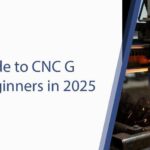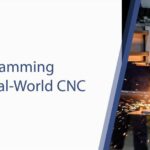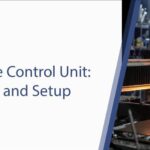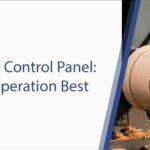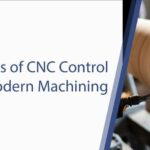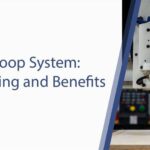In the modern manufacturing world, CNC (Computer Numerical Control) technology forms the foundation of industrial production.
Two critical components ensure the effective operation of this technology: the CNC control unit and the CNC control panel.
Although these two components are often confused with each other, they differ significantly in terms of their functions and structures.
This article will examine in detail what the CNC control panel and unit are, their main features, and the differences between them.
Overview of CNC Technology
CNC stands for “Computer Numerical Control.” This technology enables the automatic control of manufacturing equipment through computer programs.
CNC machines can process materials such as metal, wood, plastic, and others by performing precise movements based on programmed commands.The basic working principle of CNC systems is as follows:
- A digital model of a part is created using design programs (CAD).
- CAM software converts this model into G-code, which the machine can understand.
- The G-code is transferred to the CNC control unit.
- The control unit translates these codes into motor movements.
- The operator monitors the process and intervenes when necessary via the control panel.
For this process to run smoothly, it is critical that the CNC control unit and control panel work in harmony and function correctly.
What is a CNC Control Unit?
The CNC control unit can be considered the “brain” of the CNC machine. This unit is an electronic system that receives G-code (numerical commands) from the computer and converts them into machine movements.
The control unit sends commands to motion mechanisms, such as stepper motors or servo motors, enabling the machine to perform the desired movements.
Key Functions of the CNC Control Unit
- Interpreting and processing G-codes
- Sending signals to motor drivers
- Coordinating machine movements
- Monitoring feedback systems
- Detecting and correcting errors
- Storing and managing machine parameters
- Controlling safety systems
The CNC control unit typically consists of an electronic control board, a processor, memory units, and various input/output (I/O) ports.
Modern control units, equipped with high-speed processors and advanced algorithms, can perform complex motion control and precise interpolation (calculation of intermediate values).
What is a CNC Control Panel?
The CNC control panel is the interface through which the operator interacts with the CNC machine.
The control panel includes a screen that displays the machine’s status, a keypad for data entry, various function keys, and safety elements such as an emergency stop button.
Key Functions of the CNC Control Panel
- Displaying machine status and axis positions
- Allowing program input and editing
- Adjusting tool offset values
- Simulating programs
- Issuing commands for manual control (JOG mode)
- Displaying alarms and error messages
- Setting and resetting reference points
Each button on the control panel has a specific function. For example:
- POSITION button: Displays the position of the cutter on the X, Y, and Z axes.
- PROGRAM button: Allows program input or displays a running program.
- OFFSET SETTING button: Brings up the menu required to define the reference point of the cutting tool.
- EMERGENCY STOP: A safety button that completely stops the machine in emergencies.
Translation: Key Differences Between CNC Control Unit and Control Panel
Understanding the Key Differences
Understanding the fundamental differences between the CNC control unit and the control panel is essential for grasping how these systems operate.
Functional Differences
Control Unit:
- Acts as the “brain” of the machine.
- Responsible for processing G-code and controlling motors.
- Operates in the background without direct interaction with the operator.
- Performs motion calculations, interpolation, and timing operations.
- Controls machine functions (e.g., spindle speed, cooling, tool changes).
Control Panel:
- Serves as the user interface.
- Facilitates interaction between the operator and the machine.
- Allows data entry, program editing, and monitoring.
- Displays machine status and parameters.
- Enables manual control through commands.
Physical Differences
Control Unit:
- Typically located inside the machine, within the electrical cabinet.
- Composed of electronic boards, a processor, and memory components.
- May not be directly visible.
- Connected to high-voltage and signal lines.
- May include a cooling system.
Control Panel:
- Positioned outside the machine for easy operator access.
- Consists of a screen, keypad, and various buttons.
- Designed with ergonomic considerations.
- Frequently used by the operator.
- Often mounted on a movable or adjustable arm.
Components of the CNC Control Unit
The CNC control unit comprises various electronic and electromechanical components, each critical for the system’s proper functioning.
Processor and Memory: Modern CNC control units feature high-speed processors and sufficient memory. The processor processes G-code commands and performs necessary motion calculations. Memory stores programs, machine parameters, and other data. Common memory types include:
- RAM (temporary memory)
- Flash memory or EEPROM (permanent memory)
- Some systems support SD cards or USB drives.
Motor Drivers: Motor drivers convert signals from the control unit into power signals that motors can understand. They are designed differently for stepper motors or servo motors. In high-performance CNC systems, the precision and speed of motor drivers are crucial.
Input/Output (I/O) Interfaces: The control unit communicates with sensors, limit switches, solenoids, and other control elements through I/O ports. Typical I/O interfaces include:
- Digital inputs (e.g., limit switches, emergency stop, tool sensors)
- Digital outputs (e.g., coolant control, tool changes)
- Analog inputs and outputs (e.g., spindle speed control)
- Encoder inputs (for position feedback)
Communication Interfaces: Modern CNC control units support various communication protocols, enabling interaction with computers, control panels, and other devices. Common communication interfaces include:
- USB connection
- Ethernet (TCP/IP)
- EtherCAT
- RS-232/485 serial connection
- Parallel port (in older systems)
Components of the CNC Control Panel
The CNC control panel is the physical interface used by the operator to control the CNC machine. A typical control panel includes the following components:
Screen: The most visible part of the control panel, the screen displays machine status, program content, alarm messages, and other information. Modern CNC control panels often use:
- LCD screens
- Touchscreens (in newer systems)
- Color graphic displays
Keypad: The keypad is used for program input, parameter settings, and other operations. Common keys include:
- Numeric keys (0-9)
- Alphabetic keys (A-Z)
- Function keys (F1-F12)
- Directional keys (up, down, left, right)
- Special function keys (e.g., RESET, START, STOP)
Manual Control Components: Manual control components allow the operator to control the machine manually. These include:
- Axis selection buttons (X, Y, Z, etc.)
- Handwheel (for manual movement)
- JOG buttons (to manually move axes)
- Speed adjustment potentiometers (for feed rate and spindle speed)
Safety Elements: The control panel includes various elements to ensure operator safety:
- Emergency stop button (red mushroom-shaped button)
- Key switches (for authorization)
- Protective covers or enclosures
Modern Connection Technologies: Ethernet and EtherCAT
Connection technologies used in CNC control systems have evolved significantly over time, transitioning from traditional parallel ports or serial connections to modern, fast, and reliable protocols like Ethernet and EtherCAT.
Ethernet Connection: Ethernet connections are becoming increasingly common in CNC control units. Advantages include:
- High data transfer speeds (100 Mbps – 1 Gbps)
- Long cable distances (up to 100 meters)
- Network integration and remote access capabilities
- Standardized cabling and connectors
- Easy scalability
Ethernet-connected CNC control systems can be integrated into factory networks, offering remote monitoring and control capabilities.
EtherCAT Technology: EtherCAT (Ethernet for Control Automation Technology) is a real-time, Ethernet-based fieldbus system specifically developed for industrial automation. Compared to standard Ethernet, EtherCAT offers:
- Extremely low latency (in microseconds)
- Deterministic response times (predictable timing)
- High synchronization precision
- More efficient protocol structure
- The ability to control numerous devices on a single network
EtherCAT technology is ideal for high-performance CNC applications requiring precise motion control.
Key Considerations When Choosing a CNC Control Unit
Choosing the Right CNC Control Unit
When selecting a CNC control unit, it is essential to choose a model that meets the requirements of your project and machine. The following factors should be considered:
Number of Axes and Control Capacity
The number of axes the control unit can manage is a critical factor:
- 3-Axis Systems (X, Y, Z): Suitable for basic milling and engraving tasks.
- 4-Axis Systems (X, Y, Z, A): Includes an additional rotational axis for advanced operations.
- 5+ Axis Systems: Ideal for complex 3D shapes and surfaces.
Processing Speed and Frequency
The processing speed and frequency of the control unit directly affect the machine’s performance:
- Pulse Frequency: Typically measured in kHz, higher frequencies enable smoother and faster operations.
- Processor Speed and Capacity: Determines how quickly the unit can process commands.
- Memory Size and Access Speed: Impacts the unit’s ability to handle large and complex tasks.
Input/Output Capacity
Evaluate the number of input and output ports the control unit offers:
- Digital Inputs: For limit switches, sensors, and other devices.
- Digital Outputs: For controlling external devices like relays or actuators.
- Analog Input/Output Capacity: For spindle speed control or other analog devices.
- Dedicated Ports: For specialized functions.
Connection Features
A control unit with modern connection options is crucial for future integrations:
- USB Connection: Common and user-friendly.
- Ethernet/LAN Support: For high-speed and long-distance connections.
- EtherCAT Support: For real-time performance in industrial applications.
- Wireless Connection Options: For added flexibility.
Software Compatibility
Check which software the control unit is compatible with:
- Specialized CAM Software: For design and manufacturing integration.
- G-Code Generators: For creating machine-readable commands.
- Simulation Programs: For testing and optimizing operations.
- Remote Monitoring Software: For real-time tracking and control.
Key Considerations for CNC Control Panels
When selecting a CNC control panel, prioritize ease of use and functionality. Key factors include:
Ergonomics and Usability
- Button Layout and Accessibility: Ensure intuitive operation.
- Screen Size and Display Quality: For clear visibility of machine status.
- Adjustability and Positioning Flexibility: For operator comfort.
- Durability of Buttons: For long-term reliability.
Screen Features
- Screen Size and Resolution: For detailed visual feedback.
- Touchscreen Support: For modern and intuitive operation.
- Viewing Angle and Brightness: For visibility in various lighting conditions.
- Graphics and Simulation Capabilities: For enhanced usability.
Control Features
- Manual Control Options: Such as JOG mode or handwheels.
- Speed and Feed Adjustment Knobs: For real-time control.
- Special Function Buttons: For quick access to frequently used features.
- Macro Programming Capabilities: For advanced automation.
Durability and Environmental Resistance
- Dust and Moisture Protection: Check the IP rating.
- Vibration Resistance: For stable operation in industrial environments.
- Operating Temperature Range: Ensure compatibility with your workspace.
- Impact Resistance: For long-term durability.
CNC Control System Installation and Maintenance
Proper installation and regular maintenance of CNC control systems are critical for long-lasting and trouble-free operation.
Installation Tips
Control Unit Installation:
- Mount the unit in a metal enclosure to protect against electromagnetic interference.
- Ensure adequate ventilation and cooling.
- Properly connect the power supply and grounding.
- Keep signal cables separate from power cables.
- Verify that all connections are secure and stable.
Control Panel Installation:
- Mount the panel in an easily accessible location for the operator.
- Position the screen to avoid glare.
- Adjust the height and angle for ergonomic use.
- Securely and neatly connect all cables.
Regular Maintenance
Control Unit Maintenance:
- Regularly clean cooling fans and ventilation channels.
- Inspect electrical connections and tighten if necessary.
- Keep software up to date.
- Perform regular backup procedures.
Control Panel Maintenance:
- Keep the screen and keypad clean.
- Regularly check the functionality of buttons and switches.
- Ensure potentiometers and handwheels operate smoothly.
- Test the emergency stop button for proper functionality.
Future Trends
CNC control system technology is constantly evolving. Here are some trends we may see in the coming years:
Smart Control Systems
- AI-Powered Optimization: For enhanced efficiency and precision.
- Machine Learning for Error Prediction: To minimize downtime.
- Adaptive Cutting Parameters: Automatically adjusted based on material and conditions.
- Predictive Maintenance and Fault Diagnosis: For proactive system care.
Augmented Reality Integration
- AR Glasses with Integrated Control Panels: For hands-free operation.
- Virtual Screens and Interactive Controls: For enhanced usability.
- Visual Programming Assistants: For simplified programming.
- Remote Assistance and Training: Using AR technology.
Cloud-Based CNC Control
- Cloud-Based Programming and Simulation: For collaborative workflows.
- Remote Monitoring and Control: For real-time access to machine data.
- Real-Time Data Analysis: For performance optimization.
- Multi-Machine Coordination: For synchronized operations.
Improvements in Human-Machine Interfaces
- More Intuitive Control Panels: For easier operation.
- Voice Commands with Natural Language Processing: For hands-free control.
- Advanced Touch and Gesture Recognition: For modern interaction.
- Customizable Interfaces: Tailored to individual operator preferences.
Conclusion
The CNC control panel and control unit are two critical components of CNC machine systems.
As detailed in this article, the control unit acts as the “brain” of the machine, while the control panel serves as the interface between the operator and the machine. Both have their unique functions and components.
In modern CNC systems, advanced connection technologies like Ethernet and EtherCAT enable fast and reliable communication between these two components.
These technologies provide higher precision, faster processing times, and improved network integration.
When selecting a CNC control panel and control unit, it is essential to consider your machine’s requirements, intended use, and future expansion plans.
Proper selection and regular maintenance will ensure that your CNC system operates efficiently and lasts for a long time.
As technology advances, CNC control systems will become smarter, more user-friendly, and more integrated.
Artificial intelligence, augmented reality, and cloud-based control systems will set new standards for CNC technology in the future.
Contact Us:
- E-Mail: info@radonix.com
- Phone: +90 (553) 920 5500


